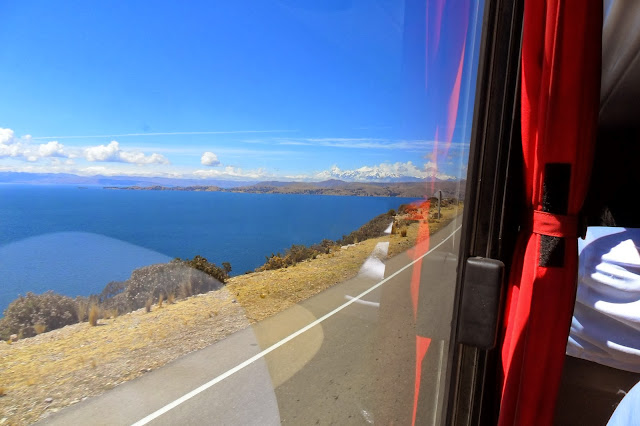Caught a bus from Potosi to Uyuni for 35 Bolivaros. Weather now getting very cold. Found a cheap 55 Bolivaro hostel and booked a tour for 1200 Bolivaros which will take me to the Chilean border, across the salt flats with an overnight stay.
Our tour group, English, Kiwis, Germans
stopped for lunch on day one at a hotel made entirely from salt blocks
Even the chairs and tables..
In the middle of the salt pan, the horizon becomes a flat line in all directions, time for some fun photography;
Since Bolivia lost a war with Chile it has not had a coastline. There is a single rail link to a Chilean port which terminates in Bolivia at this railway graveyard.
Stopped at this 'island' in the salt. Cacti grow exceedingly slowly. The biggest here are 200 years old.
Freezing cold in our overnight hotel. Tour operators supplied hot water bottles. Here mud bricks are stacked for an extension.
Volcanic hot springs provide a welcome hot break from the freezing weather.
The alkaline nature of the lakes attracts flamingos
This signs means; Don't let your actions make the birds fly.
An algal bloom gives the name to the Red Lake.
Wind blown sand has sculptured this rock into a tree shape over how many years?
This area of bubbling gaseous geysers was the highest poin we reached at over 5500 metres.
And so to Chile. Arranged a visa and was stamped out of Bolivia two days before at Uyuni. Waited for an onward bus here for a couple of hours.
Our tour group, English, Kiwis, Germans
stopped for lunch on day one at a hotel made entirely from salt blocks
Even the chairs and tables..
In the middle of the salt pan, the horizon becomes a flat line in all directions, time for some fun photography;
Since Bolivia lost a war with Chile it has not had a coastline. There is a single rail link to a Chilean port which terminates in Bolivia at this railway graveyard.
Stopped at this 'island' in the salt. Cacti grow exceedingly slowly. The biggest here are 200 years old.
Freezing cold in our overnight hotel. Tour operators supplied hot water bottles. Here mud bricks are stacked for an extension.
Volcanic hot springs provide a welcome hot break from the freezing weather.
The alkaline nature of the lakes attracts flamingos
This signs means; Don't let your actions make the birds fly.
An algal bloom gives the name to the Red Lake.
Wind blown sand has sculptured this rock into a tree shape over how many years?
This area of bubbling gaseous geysers was the highest poin we reached at over 5500 metres.
And so to Chile. Arranged a visa and was stamped out of Bolivia two days before at Uyuni. Waited for an onward bus here for a couple of hours.




















 Prize for the most unusual item offered for sale in the market goes to...dried Llama fetuses
Prize for the most unusual item offered for sale in the market goes to...dried Llama fetuses 



























